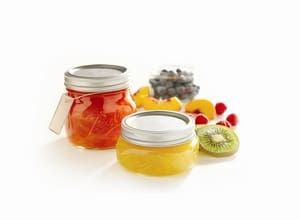 |
| Lauren Devine |
The Food Channel visited with Lauren Devine, fresh preserving community manager for Jarden Home Brands, makers of Ball® jars, home canning mixes and just about everything else needed for the preserving of fresh foods. Devine offered up opinions on the current state of the fresh preserving business in the USA. Hardly the grandmotherly type, Ms. Devine is all of 29 years old.
What’s the trend in home canning today? Are more people returning to this age-old method of preserving the summer’s harvest?
Yes, and for several reasons. Number one is probably food safety. There’s a lot of fear out there right now after the situations we’ve had in this country with contamination in tomatoes, cilantro and jalapeno peppers. People now are wanting to take produce back into their own hands and control it themselves. They’re saying, ‘I know it’s safe. I can trust this food, because I did it myself.’ Another reason, of course, is simply taste. People love that fresh flavor. And with home canning or freezing, again, they’re in control. If they want to add fresh herbs or spices—things like garlic—they can do it. If they want less sodium in their canned tomatoes, or less sugar in their canned or frozen fruit, they can do that.
Do the numbers bear that out, that more people are home canning today than in recent years?
Well, our numbers here at Jarden certainly reflect that. Our overall sales are up about 28% over last year for all our products—that includes glass jars, plastic products, and food products such as our mixes and ingredients like pectin.

Do you feel like the dramatic rises we’ve seen with food prices have had an effect on the resurgence of fresh preserving?
We do, yes. A good example of that can be seen with what’s happening with our larger jars. Our quart-size glass jars which are often used for storage of things like rice, flour and sugar have had a 40% increase in sales in the past year. People are buying in big bulk packages to save money, then transferring the contents into our Ball storage jars.
People think of home canning as something maybe their grandmother did. What about younger people…are they getting into it now?
Yep. We’ve done some recent research, sending out a survey to people interested in home canning. More than 50% of the respondents were under the age of 45, with 26% under 35.
What are some of the best foods for home canning?
Tomatoes are a really popular item for home canners. People want to hold on to that fresh taste of home-grown tomatoes as long as they can, and often they have an overabundance of them this time of year, so they can them for later use in salsas, or dice them up for pasta sauces or chili. Jams and jellies are probably an even bigger category.
What’s the shelf life for a home-canned product?
We recommend about one year. You can keep it longer than that, but color will start to diminish at that point, and a general quality will begin to decline.

Lauren demonstrates the art of canning in NYC
What are the main reasons people do home canning today?
Well, we’ve mentioned taste. Folks really like the idea of capturing the flavor of fresh produce. Another reason, I think, is the sense of accomplishment you feel when you’ve done it. It becomes sort of like a hobby for many people. And people like giving home-canned foods as gifts. There’s something special about giving a gift of something homemade.
What equipment to you need for home canning?
Not really all that much. For creating a waterbath canner to can high-acid foods such as jams, jellies, salsa and pickles, you will need a large stock pot, which most people already have in their kitchens—it just needs to be large enough so boiling water will completely surround the jars…and something like a cooling rack to put at the bottom of the pot, so the boiling water will get under the jars, too. Some other items we offer can be extremely helpful, as well. One is a jar lifter. It lets you clamp onto a jar and remove it from the hot water without burning yourself. We also have a lid lifter that helps in the same way with jar lids.
Can you offer any special tips for first-time canners, or people who are thinking about trying it for the first time?
I try to stress that you’re going to need a little patience the first time around. You kind of learn as you go along. But the first thing you should do is read the recipe all the way through before you start, to see the steps you’ll need to go through. But then once you’ve done it, you’ll say, ‘That wasn’t so hard at all.’ The other important thing is, make sure you use a tested recipe. Many people want to use a recipe that’s been handed down in their family for seven generations or something. But a lot of these heirloom recipes are not clear about things like, does this recipe call for boiling water canning or will you need a steam pressure canner? For safety sake you really need to use a tested home canning recipe.
Where can you find these ‘tested recipes’?
Well, the Ball Blue Book of Preserving is a great source, or the BALL Complete Book of Home Preserving
. The USDA has good recipes on its web site. And we’ve got all kinds of great recipes, how-to’s, video demos and other information on our Ball web site, freshpreserving.com. We also have a message board on the site now, so home canners out there can compare notes and share ideas. Plus, we have a hot line number, 1-800-240-3340, if you’d like to speak with one of our fresh preserving experts.
How Long Have You Been Doing Home Canning?
I watched my grandmother doing it when I was a little girl, but I’ve been canning myself for about six years now.
So, she started when she was 21. And, at 29, I’d say this home canning veteran has a while before she becomes a grandma.
More on Fresh Preserving

